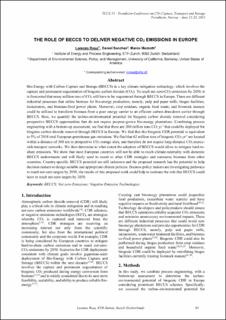| dc.contributor.author | Rosa, Lorenzo | |
| dc.contributor.author | Sanchez, Daniel | |
| dc.contributor.author | Mazzotti, Marco | |
| dc.date.accessioned | 2021-09-22T06:54:33Z | |
| dc.date.available | 2021-09-22T06:54:33Z | |
| dc.date.issued | 2021 | |
| dc.identifier.isbn | 978-82-536-1714-5 | |
| dc.identifier.issn | 2387-4295 | |
| dc.identifier.uri | https://hdl.handle.net/11250/2780214 | |
| dc.description.abstract | Bio-Energy with Carbon Capture and Storage (BECCS) is a key climate mitigation technology, which involves the capture and permanent sequestration of biogenic carbon dioxide (CO2). To reach net-zero-CO2-emissions by 2050, it is forecasted that many million tons of CO2 will have to be sequestered through BECCS in Europe. There are different industrial processes that utilize biomass for bio-energy production, namely, pulp and paper mills, biogas facilities, incinerators, and biomass-fired power plants. Moreover, crop residues, organic food waste, and livestock manure could be utilized to transform biomass from a poor energy carrier to an efficient carbon drawdown carrier through BECCS. Here, we quantify the techno-environmental potential for biogenic carbon dioxide removal considering prospective BECCS opportunities that do not require purpose-grown bio-energy plantations. Combining process engineering with a bottom-up assessment, we find that there are 200 million tons CO2 yr-1 that could be deployed for biogenic carbon dioxide removal through BECCS in Europe. We find that this biogenic CDR potential is equivalent to 5% of 2018 total European greenhouse gas emissions. We find that 62 million tons of biogenic CO2 yr-1 are located within a distance of 300 km to prospective CO2 storage sites, and therefore do not require long-distance CO2 sourcesink transport networks. We then determine to what extent the adoption of BECCS would allow to mitigate hard-toabate emissions. We show that most European countries will not be able to reach climate-neutrality with domestic BECCS endowments and will likely need to resort to other CDR strategies and outsource biomass from other countries. Country-specific BECCS potential are still unknown and the proposed research has the potential to help decision makers to design suitable and appropriate climate policies. Because policy makers are investigating pathways to reach net-zero targets by 2050, the results of this proposed work could help to estimate the role that BECCS could have to reach net-zero targets by 2050. | en_US |
| dc.language.iso | eng | en_US |
| dc.publisher | SINTEF Academic Press | en_US |
| dc.relation.ispartof | TCCS–11. CO2 Capture, Transport and Storage. Trondheim 22nd–23rd June 2021
Short Papers from the 11th International Trondheim CCS Conference | |
| dc.relation.ispartof | TCCS–11. CO2 Capture, Transport and Storage. Trondheim 22nd–23rd June 2021.
Short Papers from the 11th International Trondheim CCS Conference | |
| dc.relation.ispartofseries | SINTEF Proceedings;7 | |
| dc.rights | CC BY 4.0 | * |
| dc.rights.uri | https://creativecommons.org/licenses/by/4.0/ | * |
| dc.subject | BECCS | en_US |
| dc.subject | Net-zero Emissions | en_US |
| dc.subject | Negative Emission Technologies | en_US |
| dc.title | The Role Of Beccs To Deliver Negative CO2 Emissions In Europe | en_US |
| dc.type | Chapter | en_US |
| dc.type | Peer reviewed | en_US |
| dc.type | Conference object | en_US |
| dc.description.version | publishedVersion | en_US |
| dc.rights.holder | © 2021 The Authors. Published by SINTEF Academic Press. | en_US |
| dc.subject.nsi | VDP::Teknologi: 500 | en_US |

